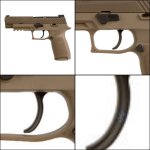the trigger was moved significantly back before it went off - enough that it reached the stage where one teaching it would say - take up the slack, then mash the trigger - he was at he wall there - zoom in and you will see it . move it a mm and it wont. its not fully cocked when the trigger is forward. it is a DA trigger pull in that it cocfks and fires with one press of the trigger.
4:29
You are using an out of date browser. It may not display this or other websites correctly.
You should upgrade or use an alternative browser.
You should upgrade or use an alternative browser.
The SIG Sauer P320 Has Never Been Good
- Thread starter 870P
- Start date
Yes the whole thing was interesting but a meaningless demonstration in terms of real world hazard. Other than the Sig, every gun had to have its trigger brought to and held on the trembling point of firing.the trigger was moved significantly back before it went off - enough that it reached the stage where one teaching it would say - take up the slack, then mash the trigger - he was at he wall there - zoom in and you will see it . move it a mm and it wont. its not fully cocked when the trigger is forward. it is a DA trigger pull in that it cocfks and fires with one press of the trigger.
There's a lot of positives in traditional DA/SA pistols. The ability to thumb down on the lowered hammer while you re-holster is a big safety plus as you will feel the hammer start to rise if something is snagged in your trigger guard.
SIG226 or S&W 3rd Gen are examples.
SIG226 or S&W 3rd Gen are examples.
1riot1ranger
CGN Regular
- Location
- Calgary, AB
I tried to replicate the Wyoming Gun Project P320 test on my P320 X5. With the trigger depressed 1-2 mm, I couldn’t get the pistol to fire no matter how hard I worked the slide into the frame. If the trigger was very nearly at the sear-release point (around 1mm from breaking), I could get it to go off by pressing the front of the slide into the frame with thumb/finger pressure.
A sample size of 1 is statistically insignificant, but there is some evidence to suggest that it’s not a universal issue.
(I have no idea what the TriggerSmart test it trying to prove…. If you move the trigger completely to the rear and manipulate the slide, it makes sense to me that the pistol might fire as the sear/striker engagement doesn’t have much going on at that point. You’ve also disarmed the safety mechanism on most striker-fired pistols by depressing the trigger that far. I don’t see what this test is trying to accomplish as the concern is these pistols going off in holsters when the trigger is *not* depressed. The argument against the 320 is that the trigger could move *slightly* and frame/slide movement in a holster during flexing could make the pistol discharge. That’s what the Wyoming Gun Project video showed and that’s what other YouTubers have replicated. I couldn’t replicate the same results with my pistol. YMMV.)
A sample size of 1 is statistically insignificant, but there is some evidence to suggest that it’s not a universal issue.
(I have no idea what the TriggerSmart test it trying to prove…. If you move the trigger completely to the rear and manipulate the slide, it makes sense to me that the pistol might fire as the sear/striker engagement doesn’t have much going on at that point. You’ve also disarmed the safety mechanism on most striker-fired pistols by depressing the trigger that far. I don’t see what this test is trying to accomplish as the concern is these pistols going off in holsters when the trigger is *not* depressed. The argument against the 320 is that the trigger could move *slightly* and frame/slide movement in a holster during flexing could make the pistol discharge. That’s what the Wyoming Gun Project video showed and that’s what other YouTubers have replicated. I couldn’t replicate the same results with my pistol. YMMV.)
The Ruger RXM looks to be the pistol to get if you want the modularity of a fire control unit, and be able to use a fair amount of Glock parts. Maybe some day we will be free and able to purchase tools as we see fit.
Any other Glock owners spent the weekend trying to get that slide to move enough to get a "click" out of manipulating it with the trigger at various tensions?
At least with my gen3, there is not enough play in the slide to get it to do anything unusual, there is just no wiggle happening for it to work with.
At least with my gen3, there is not enough play in the slide to get it to do anything unusual, there is just no wiggle happening for it to work with.
steamy teabag
CGN Ultra frequent flyer
- Location
- Inside Carneys Reich
Bad production run maybe.I tried to replicate the Wyoming Gun Project P320 test on my P320 X5. With the trigger depressed 1-2 mm, I couldn’t get the pistol to fire no matter how hard I worked the slide into the frame. If the trigger was very nearly at the sear-release point (around 1mm from breaking), I could get it to go off by pressing the front of the slide into the frame with thumb/finger pressure.
A sample size of 1 is statistically insignificant, but there is some evidence to suggest that it’s not a universal issue.
(I have no idea what the TriggerSmart test it trying to prove…. If you move the trigger completely to the rear and manipulate the slide, it makes sense to me that the pistol might fire as the sear/striker engagement doesn’t have much going on at that point. You’ve also disarmed the safety mechanism on most striker-fired pistols by depressing the trigger that far. I don’t see what this test is trying to accomplish as the concern is these pistols going off in holsters when the trigger is *not* depressed. The argument against the 320 is that the trigger could move *slightly* and frame/slide movement in a holster during flexing could make the pistol discharge. That’s what the Wyoming Gun Project video showed and that’s what other YouTubers have replicated. I couldn’t replicate the same results with my pistol. YMMV.)
1riot1ranger
CGN Regular
- Location
- Calgary, AB
That’s a definite possibility. It could also be an issue of stacking tolerances.Bad production run maybe.
One thing that sets the P320 apart from, say, the Glock is the FCU. To make the P320 “modular”, the tolerances and clearance between the FCU sear and the striker could be “looser” than they probably should be. (This is just speculation on my part - not looking for an argument or lawsuit…). The ability to swap the FCU is great, but on certain models the slide/frame fit could have inadequate engagement of the sear and striker. This, coupled with the MIM parts (accelerated wear and possible QA/QC concerns) and possible fouling may “stack” to create a dangerous situation when the pistol is holstered. Frame flex or “jostling” while holstered may be enough to release the sear and send the striker forward.
Because my P320 is the X5 competition model, it might get another level of QA/QC or have slightly higher tolerances. I really don’t know. I was excited to get the P320 because of its modularity and the potential to swap out frames and slides to create a number of different pistols or even a PCC. I don’t think I’ll be investing in any of that until there is some kind of solution from SIG.
I don’t pretend to have “the” answer. It’s a terrible situation and the path(s) to resolution are likely very few.
steamy teabag
CGN Ultra frequent flyer
- Location
- Inside Carneys Reich
Sig may come up with a fix but if it involves sending a 320 south for repair or warranty Poly will burn the email and phone lines down to stop it.
Plot twist: Sig Sauer re-launches the P250 as the only financially viable solution to P320 woes 
For the poster to mentioned replicating the sear manipulation in a Glock: In Glocks and (probably) every other striker-fired pistol, it is essentially mechanically impossible to do so. Apart from the complexities of sear-striker engagement of the P320 FCU to the (loose fit) slide design and before any concerns of parts production, tolerance stacking, safety mechanisms, etc, the P320 has the striker fully cocked. Glocks and other striker-fired pistols operate on the basis that the striker is only partially compressed and then fully compressed when the trigger bar is actuated. This is why the P320 is indeed regarded for its trigger feel because it is essentially performing a 'single-action' whereas others are more akin to a 'double-action' (obviously not to suggest either are mechanically the same or feel like a hammer-fired SAO or DA/SA system).
For the poster to mentioned replicating the sear manipulation in a Glock: In Glocks and (probably) every other striker-fired pistol, it is essentially mechanically impossible to do so. Apart from the complexities of sear-striker engagement of the P320 FCU to the (loose fit) slide design and before any concerns of parts production, tolerance stacking, safety mechanisms, etc, the P320 has the striker fully cocked. Glocks and other striker-fired pistols operate on the basis that the striker is only partially compressed and then fully compressed when the trigger bar is actuated. This is why the P320 is indeed regarded for its trigger feel because it is essentially performing a 'single-action' whereas others are more akin to a 'double-action' (obviously not to suggest either are mechanically the same or feel like a hammer-fired SAO or DA/SA system).
Leavenworth
CGN frequent flyer
- Location
- Lowermainland B.C.
Could some of the pistol Gurus help me out with this ?I have not read through the whole thread yet but I will .
I have an Sig P320 Full Frame bought it new just before the ban . I will have to look at my old thread concerning the issue , Apparently it has the upgrade .
But is the P320 still firing when not intended to by the operator on these upgraded pistols ?
Is my pistol safe ?
This came up on my YouTube algorithm today
And this
Also what could be done to make a P320 safer . Yeah I know don’t use it .
Thank You
To answer the question, yes. I did just that and on G21 Gen 3, G17 Gen 4, G48 Gen 5, there is no movement in the fitment. When the slide is closed, zero on the front and minimal at the rear. For a Glock to discharge, the trigger must be pulled past the break wall, or when chambered cooked in a fire.Any other Glock owners spent the weekend trying to get that slide to move enough to get a "click" out of manipulating it with the trigger at various tensions?
At least with my gen3, there is not enough play in the slide to get it to do anything unusual, there is just no wiggle happening for it to work with.
1riot1ranger
CGN Regular
- Location
- Calgary, AB
Here’s the best video I’ve seen on the P320 saga explaining the problem and a potential solution for the problem.
EDIT: the solution looks like a similar design that’s about 114 years old.
EDIT: the solution looks like a similar design that’s about 114 years old.
Last edited:
Leavenworth
CGN frequent flyer
- Location
- Lowermainland B.C.
Okay here’s something else !
What are the chances that Sig will recall all P 320’s and fix them ,either with the fix above or something else ?
What are the chances that Sig will recall all P 320’s and fix them ,either with the fix above or something else ?













































































